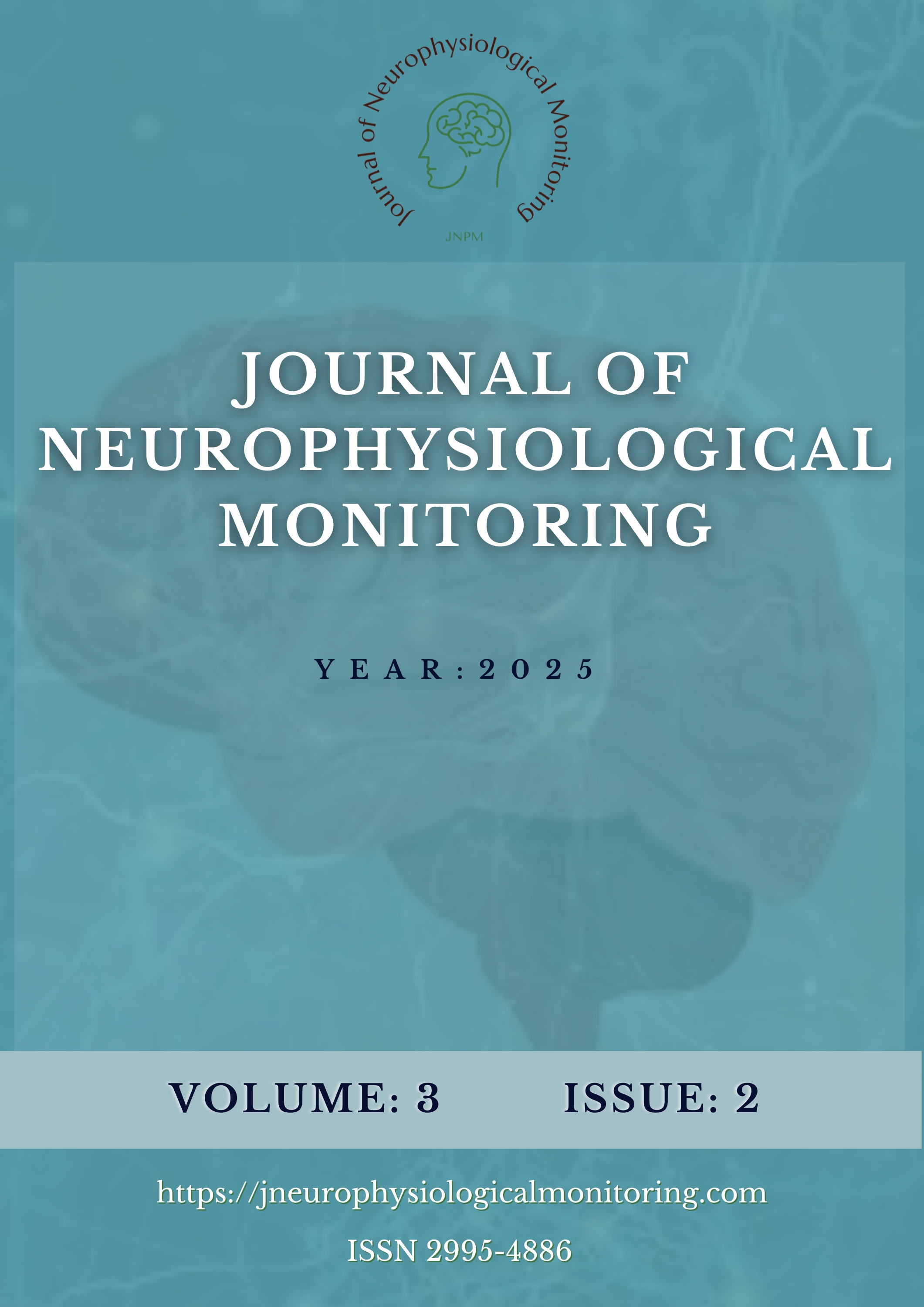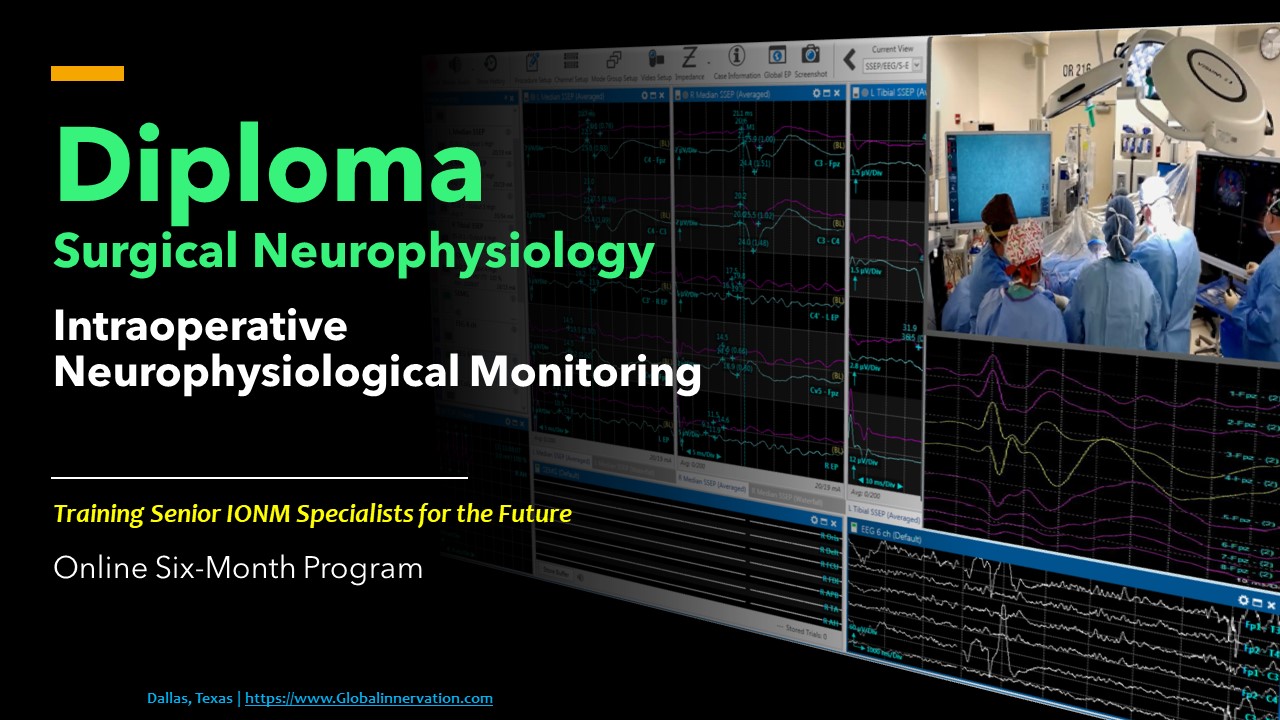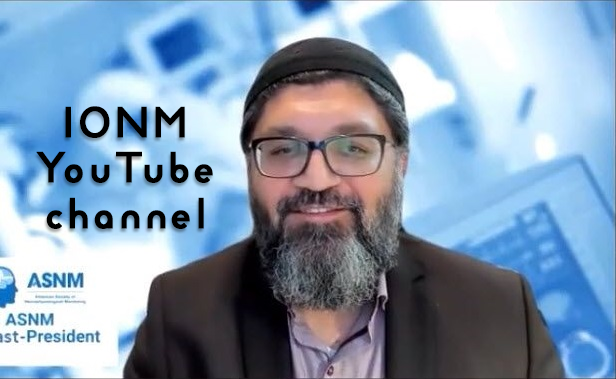The Mapping of the Sensory Circuits in the Spinal Cord: A Literature Review
DOI:
https://doi.org/10.5281/zenodo.15542995Keywords:
Sensory Circuit, Spinal Cord, Spinal Segment, Spinal Dermatome, SSEP, Somatosensory Evoked Potentials, Proprioception, Tactile Discrimination, Stereognosis, Vibration Discrimination, Weight Discrimination, Pain, Temperature, MEP, Motor Evoked Potentials, Reflexes, H-Reflex, Bulbocavernosus Reflex, BCR, Neuromodulation, Plasticity, Computational Modeling, Spinal NetworkAbstract
The understanding of the sensory circuit of the spinal cord has greatly advanced with the evolution of neuroscience. Scientific breakthroughs such as that of intraoperative neuromonitoring (IONM) methods have played key parts in the enhancement of general comprehension of the anatomical, functional, and neurophysiological systematic complexities of the spinal cord. This literary review works to shed light on the utilization of IONM modalities for the purpose of mapping the sensory circuits of the spinal cord, while evaluating the practicality of several IONM modalities as a means to assist surgical interventions pertinent to spinal cord injuries. The importance of plasticity on the issue of spinal cord injuries, as well as the functionality of computational modeling of the spinal cord is also considered.
References
Johal J, Loukas M, Oskouian RJ, Tubbs RS. The early history of our understanding of the functions of the spinal cord. Childs Nerv Syst. 2018 Nov;34(11):2123–5.
Naderi S, Türe U, Pait TG. History of spinal cord localization. FOC. 2004 Jan;16(1):1–6.
Mazzola L, Isnard J, Peyron R, Mauguière F. Stimulation of the human cortex and the experience of pain: Wilder Penfield’s observations revisited. Brain. 2012 Feb 1;135(2):631–40.
Daniel Schwartz. Testimony of Daniel M. Schwartz, Ph.D. on the Historical Role of the Audiologist in Intraoperative Neurophysiological Monitoring. 2013.
Tamaki T, Kubota S. History of the development of intraoperative spinal cord monitoring. Eur Spine J. 2007 Nov;16(S2):140–6.
Gonzalez AA, Shilian P, Hsieh P. Spinal Cord Mapping. Journal of Clinical Neurophysiology. 2013 Dec;30(6):604–12.
Shimony N, Fehnel K, Abbott IR, Jallo GI. The evolution of spinal cord surgery: history, people, instruments, and results. Childs Nerv Syst. 2023 Oct;39(10):2687–700.
Thau L, Reddy V, Singh P. Anatomy, Central Nervous System. In: StatPearls [Internet]. Treasure Island (FL): StatPearls Publishing; 2024 [cited 2024 Nov 27]. Available from: http://www.ncbi.nlm.nih.gov/books/NBK542179/
Moini J. Functional and clinical neuroanatomy: a guide for health care professionals. 1st ed. San Deigo: Elsevier; 2020.
Moreno-López Y, Hollis ER. Sensory Circuit Remodeling and Movement Recovery After Spinal Cord Injury. Front Neurosci. 2021 Dec 8;15:787690.
Todd AJ. An Historical Perspective: The Second Order Neuron in the Pain Pathway. Front Pain Res. 2022 Mar 8;3:845211.
Hofstoetter US, Perret I, Bayart A, Lackner P, Binder H, Freundl B, et al. Spinal motor mapping by epidural stimulation of lumbosacral posterior roots in humans. iScience. 2021 Jan;24(1):101930.
Dale Purves. Neuroscience. 6th ed. USA: Oxford University Press; 2017.
Takeoka A, Arber S. Functional Local Proprioceptive Feedback Circuits Initiate and Maintain Locomotor Recovery after Spinal Cord Injury. Cell Reports. 2019 Apr;27(1):71-85.e3.
Wang L, Ma L, Yang J, Wu J. Human Somatosensory Processing and Artificial Somatosensation. Cyborg Bionic Syst. 2021 Jan;2021:2021/9843259.
Delhaye BP, Long KH, Bensmaia SJ. Neural Basis of Touch and Proprioception in Primate Cortex. In: Prakash YS, editor. Comprehensive Physiology [Internet]. 1st ed. Wiley; 2018 [cited 2024 Nov 27]. p. 1575–602. Available from: https://onlinelibrary.wiley.com/doi/10.1002/cphy.c170033
Calderone A, Cardile D, De Luca R, Quartarone A, Corallo F, Calabrò RS. Brain Plasticity in Patients with Spinal Cord Injuries: A Systematic Review. IJMS. 2024 Feb 13;25(4):2224.
Levine AJ, Lewallen KA, Pfaff SL. Spatial organization of cortical and spinal neurons controlling motor behavior. Current Opinion in Neurobiology. 2012 Oct;22(5):812–21.
Shkorbatova P, Lyakhovetskii V, Pavlova N, Popov A, Bazhenova E, Kalinina D, et al. Mapping of the Spinal Sensorimotor Network by Transvertebral and Transcutaneous Spinal Cord Stimulation. Front Syst Neurosci. 2020 Oct 9;14:555593.
Tropeano MP, Rossini Z, Franzini A, Capo G, Olei S, De Robertis M, et al. Multimodal Intraoperative Neurophysiological Monitoring in Intramedullary Spinal Cord Tumors: A 10-Year Single Center Experience. Cancers. 2023 Dec 25;16(1):111.
Bennett J, Das JM, Emmady PD. Spinal Cord Injuries. In: StatPearls [Internet]. Treasure Island (FL): StatPearls Publishing; 2024 [cited 2024 Nov 27]. Available from: http://www.ncbi.nlm.nih.gov/books/NBK560721/
Dlamini M. Spinal cord pathways. South Afr J Anaesth Analg. 2020 Nov 19;S40–4.
Niu J, Ding L, Li JJ, Kim H, Liu J, Li H, et al. Modality-Based Organization of Ascending Somatosensory Axons in the Direct Dorsal Column Pathway. J Neurosci. 2013 Nov 6;33(45):17691–709.
Filler T. Sensory Innervation of the Sacroiliac Joint. In: Jerosch J, editor. Minimally Invasive Spine Intervention [Internet]. Berlin, Heidelberg: Springer Berlin Heidelberg; 2023 [cited 2024 Nov 27]. p. 133–41. Available from: https://link.springer.com/10.1007/978-3-662-63814-9_11
Aage R Møller. Sensory Systems: Anatomy and Physiology. 2nd ed. Createspace; 2012.
Banks RW, Ellaway PH, Prochazka A, Proske U. Secondary endings of muscle spindles: Structure, reflex action, role in motor control and proprioception. Experimental Physiology. 2021 Dec;106(12):2339–66.
Deletis V, Vodusek DB. Intraoperative Recording of the Bulbocavernosus Reflex: Neurosurgery. 1997 Jan;40(1):88–93.
Skinner S, Chiri CA, Wroblewski J, Transfeldt EE. Enhancement of the Bulbocavernosus Reflex During Intraoperative Neurophysiological Monitoring through the Use of Double Train Stimulation: A Pilot Study. J Clin Monit Comput. 2007 Feb;21(1):31–40.
Morota N. Intraoperative neurophysiological monitoring of the bulbocavernosus reflex during surgery for conus spinal lipoma: what are the warning criteria? Journal of Neurosurgery: Pediatrics. 2019 May;23(5):639–47.
Choi J, Kim JS, Hyun SJ, Kim KJ, Kim HJ, Deletis V, et al. Intraoperative bulbocavernosus reflex monitoring in posterior lumbar fusion surgery. Clinical Neurophysiology. 2022 Dec;144:59–66.
Skinner SA, Vodušek DB. Intraoperative Recording of the Bulbocavernosus Reflex. Journal of Clinical Neurophysiology. 2014 Aug;31(4):313–22.
Rodi Z, Vodušek DB. Intraoperative monitoring of the bulbocavernosus reflex: the method and its problems. Clinical Neurophysiology. 2001 May;112(5):879–83.
Cha S, Wang KC, Park K, Shin HI, Lee JY, Chong S, et al. Predictive value of intraoperative bulbocavernosus reflex during untethering surgery for post-operative voiding function. Clinical Neurophysiology. 2018 Dec;129(12):2594–601.
Sala F, Kržan MJ, Deletis V. Intraoperative neurophysiological monitoring in pediatric neurosurgery: why, when, how? Childs Nerv Syst. 2002 Jul;18(6–7):264–87.
Nonaka M, Itakura T, Iwamura H, Ueno K, Naito N, Miyata M, et al. Comparison of intraoperative neurophysiological monitoring methods for lumbosacral lipoma surgery in infants. Childs Nerv Syst. 2023 Jun;39(6):1603–10.
Fisher MA. H reflexes and F waves Fundamentals, normal and abnormal patterns. Neurologic Clinics. 2002 May;20(2):339–60.
Leppanen RE. Monitoring Spinal Nerve Function With H-Reflexes. Journal of Clinical Neurophysiology. 2012 Apr;29(2):126–39.
Choi J, Díaz-Baamonde A, Sánchez Roldán MDLÁ, Mirallave Pescador A, Kim JS, Téllez MJ, et al. Advancing Intraoperative Neurophysiological Monitoring With Human Reflexes. J Clin Neurol. 2024;20(2):119.
Misiaszek JE. The H‐reflex as a tool in neurophysiology: Its limitations and uses in understanding nervous system function. Muscle and Nerve. 2003 Aug;28(2):144–60.
Gajos A, Kujawski S, Gajos M, Chatys Ż, Bogacki P. Applications of the H-reflex in kinesiology: a systematic review. Biomedical Human Kinetics [Internet]. 2014 Dec 11 [cited 2024 Nov 28];6(1). Available from: https://www.sciendo.com/article/10.2478/bhk-2014-0017
Eftekhar A, Norton JJS, McDonough CM, Wolpaw JR. Retraining Reflexes: Clinical Translation of Spinal Reflex Operant Conditioning. Neurotherapeutics. 2018 Jul;15(3):669–83.
Nishikawa T, Grabiner MD, Melnick M, Nishikawa T, Grabiner MD. Peroneal Motoneuron Excitability Increases Immediately Following Application of a Semirigid Ankle Brace. J Orthop Sports Phys Ther. 1999 Mar;29(3):168–76.
Grindstaff TL, Beazell JR, Sauer LD, Magrum EM, Ingersoll CD, Hertel J. Immediate effects of a tibiofibular joint manipulation on lower extremity H-reflex measurements in individuals with chronic ankle instability. Journal of Electromyography and Kinesiology. 2011 Aug;21(4):652–8.
Fawcett JW. Recovery from spinal cord injury: regeneration, plasticity and rehabilitation. Brain. 2009 Jun 1;132(6):1417–8.
Maier IC, Baumann K, Thallmair M, Weinmann O, Scholl J, Schwab ME. Constraint-Induced Movement Therapy in the Adult Rat after Unilateral Corticospinal Tract Injury. J Neurosci. 2008 Sep 17;28(38):9386–403.
Oudega M, Perez MA. Corticospinal reorganization after spinal cord injury. The Journal of Physiology. 2012 Aug;590(16):3647–63.
Onifer SM, Smith GM, Fouad K. Plasticity After Spinal Cord Injury: Relevance to Recovery and Approaches to Facilitate It. Neurotherapeutics. 2011 Apr;8(2):283–93.
Liao CC, Reed JL, Qi HX, Sawyer EK, Kaas JH. Second-order spinal cord pathway contributes to cortical responses after long recoveries from dorsal column injury in squirrel monkeys. Proc Natl Acad Sci USA. 2018 Apr 17;115(16):4258–63.
Freund P, Schmidlin E, Wannier T, Bloch J, Mir A, Schwab ME, et al. Nogo-A–specific antibody treatment enhances sprouting and functional recovery after cervical lesion in adult primates. Nat Med. 2006 Jul 1;12(7):790–2.
Barritt AW, Davies M, Marchand F, Hartley R, Grist J, Yip P, et al. Chondroitinase ABC Promotes Sprouting of Intact and Injured Spinal Systems after Spinal Cord Injury. J Neurosci. 2006 Oct 18;26(42):10856–67.
Maier IC, Ichiyama RM, Courtine G, Schnell L, Lavrov I, Edgerton VR, et al. Differential effects of anti-Nogo-A antibody treatment and treadmill training in rats with incomplete spinal cord injury. Brain. 2009 Jun;132(Pt 6):1426–40.
Oliveira DS, Ponfick M, Braun DI, Osswald M, Sierotowicz M, Chatterjee S, et al. A direct spinal cord–computer interface enables the control of the paralysed hand in spinal cord injury. Brain. 2024 Oct 3;147(10):3583–95.
Bruel A, Abadía I, Collin T, Sakr I, Lorach H, Luque NR, et al. The spinal cord facilitates cerebellar upper limb motor learning and control; inputs from neuromusculoskeletal simulation. Faisal AA, editor. PLoS Comput Biol. 2024 Jan 2;20(1):e1011008.
Balbinot G. Neuromodulation to guide circuit reorganization with regenerative therapies in upper extremity rehabilitation following cervical spinal cord injury. Front Rehabil Sci. 2024 Jan 3;4:1320211.
Liang L, Damiani A, Del Brocco M, Rogers ER, Jantz MK, Fisher LE, et al. A systematic review of computational models for the design of spinal cord stimulation therapies: from neural circuits to patient‐specific simulations. The Journal of Physiology. 2023 Aug;601(15):3103–21.
Downloads
Published
How to Cite
Issue
Section
License
Copyright (c) 2025 J of Neurophysiological Monitoring

This work is licensed under a Creative Commons Attribution 4.0 International License.





